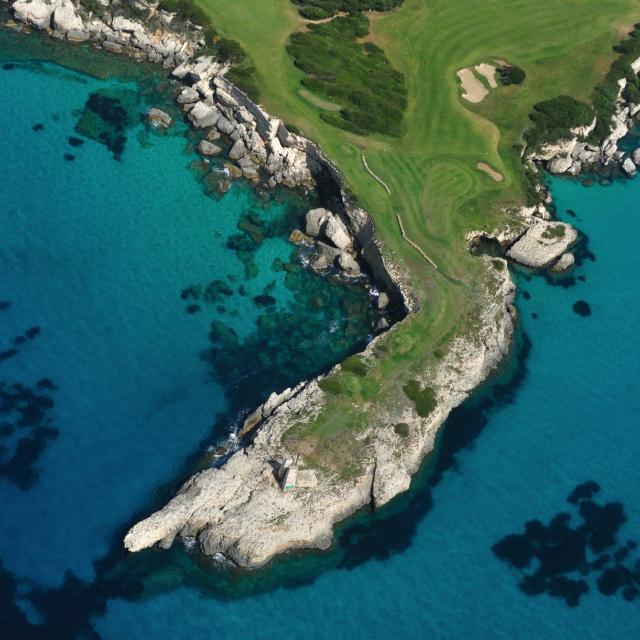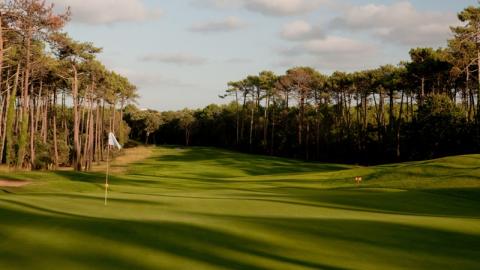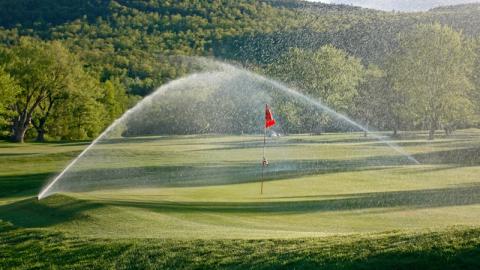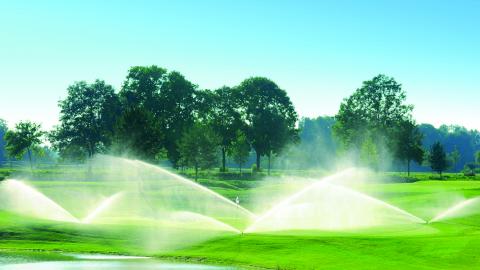After having been the object of much finger-pointing by environmental organisations, the French Golfing Association, as part of a “National Golf and the Environment Charter” signed with the Sports Ministry, is committed to reducing its consumption of water resources.

By keeping the greens and fairways lushthroughout the year, the golf clubs have been under the spotlight of the environmental associations for some time now. They have been accused of irrigatingexcessively, of usinghigh doses of chemicalfertilisers… However, itwillsoonbe 10 yearssince the French Golf Association withits 630 affiliates and their 33,000 hectares of playing area began to rebuildits image.
In 2006, the Federationsigned the first National “Golf and the Environment” charter with the Ministry of Sport, based on the conservation of water resources. Its objective is « To support the structures sothattheycanreducetheirconsumption”, explained Thomas Charrier, whoisresponsible for environmentalmatters. Verysoon, almost all of the golf courses in France hadtaken up thisenvironmental challenge and they have spared no expense in ensuringitssuccess. Most of the clubs have renewedtheir irrigation system and evenembarkedupon super-efficient IT programmes, enablingthem to manage their irrigation system according to specificparameterssuch as precipitation rate, soilmoisture content…
Other clubs have created holding tanks, whichenablethem to collectrainwatersothattheycanbecome self-sufficient, or almost, in water. This is the case with Golf National, whowanted to take the lead; the Evian Resort Golf Club, whoincorporatedthisideainto the renovationworkcarried out on its “Major” golf course in 2013; or even the Bondues Golf Course, in Lille, where the surplus fromits water obstacles ispumpedinto a hugestoragefacilityused to irrigate the greens, approaches and fairways. Thenwe have a design thatis not onlyecological but alsoeconomic: the Lille golf course saves 25,000 euros on its mains water bill. A third avenue to beexploredisbeingconnected to the nearbytreatment plant so as to make use of the (recycled) wastewater. A number of clubs on the Atlantic coast have opted for this solution: Royan, Pornic, Rhuys Kerven and also Sainte-Maxime, on the Côte d'Azur and Sperone, in Corsica.
“The progress made in irrigation isstaggering”, explained Denis Fabre, president of the Golf Directors’ Association. “The streamers are far more accurate in defining more precisely the target areas to beirrigated, with the 180-degree spray jets beingusedinstead of the 360-degree modelsusedpreviously.
To reduceconsumption, a number of golf courses are alsousing the method of reducing the leaf area index.” This involves the progressive replacement of their green areas withgrassspeciesthat consume less water. That isexactlywhat has happened on all the fairways of the Fontainebleau Golf Course and the greens of the Pont Royal Golf Course in Provence.
The resultisthat the averageconsumption of a 9-hole golf course isnow 20,000 m3 per year. The clubs have reduced by 20% the use of water from the public networks and overallconsumption by 14%. “We are fullyfocused on obtainingevenfurtherreductions”, added Denis Fabre. “However, at the same time itis important to educateourplayers.” They must be made to understandthat a dry turf is not necessarily a “rustic” golf course. In Chantilly, the fairways have dry grassduringmost of the summerseason, whichdoes not preventthis course frombeingconsidered one of the mostbeautiful in France. This change is not onlylimited to France: the browngrass on the fairways of Royal Saint George during the 2011 British Open or WhistlingStraits, in Wisconsin, during the last USPGA, may have taken a large number of TV viewers by surprise.
The return of species tha thad totally disappeared
Another important point is the use of plant healthproducts. In this respect, the golf courses have sometimes been unfairlycriticised. Thesechemicalfertilisers are mainlyused on the greens and tees, representing 2 to 3 hectares on an 18-hole course, whichishardlyanything. And eventhough the greenkeepers, showingsomewillingness on their part and followingfocussedawareness training, have by and large restrictedtheir use, itwouldbeverydifficult to do withoutthementirely. The world famousEsery golf course, near Geneva, has tentativelyexperimentedwith a totallynatural system on a 9-hole course. Afterthreeyears of operation, the club director, Emmanuel Ballongue, notedthateven if the course as a wholewas more thanpresentable, plant diseasesstilldeveloped. “I have arrivedat the conclusion thatwecannotreallyavoidapplying one or twotreatments per year, at least before the winter”, headded. “On the other hand, we have seen the return of speciesthathadtotallydisappeared, such as the yellow-belliedtoad, an extremely rare member of the frogfamily”.
Fauna and florawillbe the Federation’s main priority for 2016. In partnershipwith the National Natural Historymuseum, itwillbecarrying out a biodiversitystudy on a selection of “pilot” golf courses, in order to draw up a compendium of good practices for preservingournaturalheritage. In 2008, the national golf association compiled an inventory. Theywere able to identify 780 species and confirmthat a good number of thesehadreappearedafter an absence of almost 25 years in thisveryurbanenvironment. That issurely a positive factor for golf courses in France.



